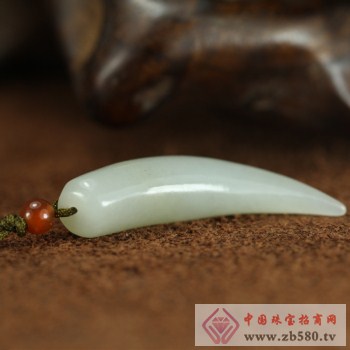Western Han Dynasty White Jade: A jade jade made with Xinjiang Hetian jade
Who has not encountered a difficult rope? When people encounter a mess like a mess, either the temperament is slowly untied or it is directly twisted with scissors. At this point, the ancients seemed to be smarter, specializing in inventing the knot--------------------- Since ancient times, the versatile and complex style of enamel has not only practical value, but also is very beautiful and beautiful. Just like crafts, people can't help but praise the wisdom of the ancients. In the Hefei area, the unwrapped craftsmanship made by the best Xinjiang Hetian jade, the Western Han Dynasty, was unearthed. This white jade unearthed in the tomb of Wang Gang in Chaohu City, the value of the cultural relics and artistic value made the cultural relics experts of that year quite surprised. Symbolic wisdom "Guo Feng·Wei Feng·Yu Lan" contains: "The branch of the orchids, the boy's son Pei; although the Pei, can not know me; Rong Wei, the slings. The leaves of the orchids, the boy Pei Although Pei, can not be my A; Rong Rong, 垂 悸兮." This poem from the "Book of Songs" vividly reproduces the folk customs of the Han people in the pre-Qin period, among which "boys Pei" is A custom that was popular at the time, so in the ancient "Year of the Year" is also the meaning of "childhood." "觿 is an ancient agglomerated awl. Zhou people are very particular about etiquette. When dressing a tie, in order to prevent the clothes from falling apart, the clothes will fall off the rude, and the clothes will often be knotted, so they will wear the knot. The tool - 觿. 觿 is made of bones, such as bones, but also made of jade. Because the ancients advocate jade, jade is the most common and most expensive one. In the beginning, 觿 is the solution The tool of the knot was slowly developed into a symbolic ornament," said Qian Yuchun, deputy director of the Municipal Cultural Relics Management Office. So, what symbolism does 觿 have gradually gained? The Western Han Dynasty writer Liu Xiang once wrote a book called "Shu Yuan", which recorded some historical stories and legends from the pre-Qin to the Western Han Dynasty. The book mentions the symbolic meaning of the shackles - "can swear by the troubled people." "In the Han Dynasty, people represented themselves as the gentleman who was able to solve problems and solve problems. It can be said that the emperors of the emperor loved to wear jade, even after death, they would wear them." Explain, "With the emergence and popularity of jade hooks that are easier to bundle and loosen, the ancients no longer need to tie the belt to a knot. At this time, the jade will gradually lose its use, and it will become a symbol of intelligence and ability. Decorations." Jade is the leader of jade The Western Han Dynasty white jade burial in the tomb of Wang Ganggang is only 4.7 cm long, 2 cm wide and only 0.4 cm thick. The lines of the entire jade are simple and clear, and the carving skills are skillful. The wide section is carved into the bird's head, and the pointed section is the bird's long tail, which is naturally drooping and smooth. The bird's shape is engraved on both sides of the jade body. The bird's head is engraved with a circular perforation for wearing a rope to tie the jade. Qian Yuchun, who has studied the jade, told reporters that the shape of each dynasty is different. The mausoleum of the Neolithic Age is flat-angled and has a pattern. During the Shang and Zhou Dynasties, the shape of the jade is simple, and it is decorated with simple outlines. The shape of the jade has changed greatly during the Spring and Autumn Period and the Warring States Period. The jade is carved into dragons, tigers, beasts, birds and other animal images. The animal's head is the upper end, the tail is carved into the tip, and the animal's body is bent into a natural curve. The shape is vivid, the charm is vivid, and the practical value and decorative value are perfectly combined. In the Han Dynasty, the shape of the jade became more and more concise, which was not unrelated to the aesthetic orientation of the Han Dynasty and the mentality of the times. Of course, although the shape of the various generations of jade is not small, it has never departed from the basic features of the large head and sharp tail. "There was no excavation of the jade in the Tomb of the North Mountain of the Chaohu Lake. Compared with this white jade white jade, it is not only half bigger, but also has a complex and colorful shape. It looks like a proud phoenix bird. Clouds and hollow shapes also make the phoenix birds look more vivid. The poor shape of the two jade plaques actually reflects the differences in aesthetic styles between the Warring States and the Han Dynasty, as well as the differences in people's ideology, so we can see artifacts through cultural relics. A lot of information about the era, this is also one of the very important values ​​of cultural relics." Qian Yuchun said. What makes Qian Yuchun relish is the jade of this white jade. "The jade that was unearthed from the tomb of Wang Gang Han is basically Xinjiang Hetian jade, but only the jade of this jade is the best. The white jade in Hetian jade, touched the Wenyu gel, looks fine and pure, and the ancients love the unobtrusive and unobtrusive beauty of this jade, because it can pin their noble character. The pursuit." Oxford Woven Dyed Farbic,Oxford Woven Cloth,T/C Dyed Farbic,Soft Feeling Dyed Farbic SHAOXING CITY CHENYAO TEXTILE CO,LTD , https://www.chenyaotextile.com
